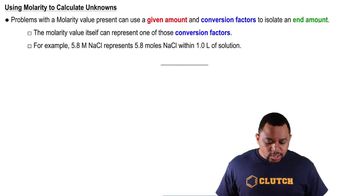Citric acid, C6H8O7, is a triprotic acid. It occurs naturally in citrus fruits like lemons and has applications in food flavouring and preservatives. A solution containing an unknown concentration of the acid is titrated with KOH. It requires 23.20 mL of 0.500 M KOH solution to titrate all three acidic protons in 100.00 mL of the citric acid solution. Calculate the molarity of the citric acid solution.
Ch.4 - Reactions in Aqueous Solution
Chapter 4, Problem 105d
Suppose you have 3.00 g of powdered zinc metal, 3.00g of powdered silver metal and 500.0 mL of a 0.2 M copper(II) nitrate solution. (d) What is the molarity of Cu2+ ions in the resulting solution?
 Verified step by step guidance
Verified step by step guidance1
insert step 1> Calculate the moles of copper(II) nitrate in the solution using the formula: moles = molarity \times volume. Remember to convert the volume from mL to L.
insert step 2> Write the balanced chemical equations for the reactions of zinc and silver with copper(II) nitrate.
insert step 3> Determine the limiting reactant by calculating the moles of zinc and silver and comparing them to the stoichiometry of the reactions.
insert step 4> Calculate the moles of Cu^{2+} ions that react based on the limiting reactant and the stoichiometry of the reaction.
insert step 5> Subtract the moles of Cu^{2+} ions that reacted from the initial moles of Cu^{2+} ions to find the moles of Cu^{2+} ions remaining. Then, calculate the molarity of Cu^{2+} ions in the resulting solution by dividing the remaining moles by the total volume of the solution in liters.

Verified Solution
Video duration:
12mWas this helpful?
Key Concepts
Here are the essential concepts you must grasp in order to answer the question correctly.
Molarity
Molarity is a measure of concentration defined as the number of moles of solute per liter of solution. It is expressed in moles per liter (M). To calculate molarity, one must know the amount of solute in grams, convert it to moles using the molar mass, and then divide by the volume of the solution in liters.
Recommended video:
Guided course

Molarity
Stoichiometry
Stoichiometry involves the calculation of reactants and products in chemical reactions. It is based on the balanced chemical equation, which shows the ratio of moles of each substance involved. Understanding stoichiometry is essential for determining how much of each reactant is consumed and how much product is formed, which is crucial for calculating concentrations after a reaction.
Recommended video:
Guided course

Stoichiometry Concept
Copper(II) Nitrate Dissociation
Copper(II) nitrate (Cu(NO3)2) dissociates in solution to release Cu2+ ions and nitrate ions (NO3-). The dissociation is complete in a strong electrolyte like copper(II) nitrate, meaning that the concentration of Cu2+ ions in the solution will be equal to the initial molarity of the copper(II) nitrate solution, assuming no other reactions consume the Cu2+ ions.
Recommended video:
Guided course

Percent Dissociation Example
Related Practice
Textbook Question
2019
views
Textbook Question
(c) If 18.65 mL
of the caesium hydroxide solution was needed to neutralize a
42.3 mL aliquot of the hydroiodic acid solution, what is the
concentration (molarity) of the acid?
492
views
Textbook Question
Suppose you have 3.00 g of powdered zinc metal, 3.00g of powdered silver metal and 500.0 mL of a 0.2 M copper(II) nitrate solution. (a) Which metal will react with the copper(II) nitrate solution?
330
views
Textbook Question
(a) By titration, 15.0 mL of 0.1008 M sodium hydroxide is needed to neutralize a 0.2053-g sample of a weak acid. What is the molar mass of the acid if it is monoprotic?
1329
views
Textbook Question
(b) An elemental analysis of the acid indicates that it is composed of 5.89% H, 70.6% C, and 23.5% O by mass. What is its molecular formula?
1437
views
Textbook Question
The discovery of hafnium, element number 72, provided
a controversial episode in chemistry. G. Urbain, a French
chemist, claimed in 1911 to have isolated an element
number 72 from a sample of rare earth (elements 58–71)
compounds. However, Niels Bohr believed that hafnium
was more likely to be found along with zirconium than
with the rare earths. D. Coster and G. von Hevesy, working
in Bohr's laboratory in Copenhagen, showed in 1922 that
element 72 was present in a sample of Norwegian zircon,
an ore of zirconium. (The name hafnium comes from the
Latin name for Copenhagen, Hafnia).
(c) Solid zirconium
dioxide, ZrO2, reacts with chlorine gas in the presence
of carbon. The products of the reaction are ZrCl4 and two
gases, CO2 and CO in the ratio 1:2. Write a balanced chemical
equation for the reaction.
655
views
